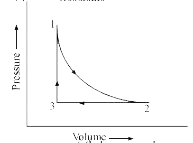For which ΔfHΘ is zero?
(a) H
(b) H−
(c) H+
(d) H+(aq)
The correct Answer is:D
To solve the question "For which Δ_fH° is zero?", we need to analyze the concept of standard enthalpy of formation (Δ_fH°) and the conditions under which it is considered to be zero.
1. Understanding Standard Enthalpy of Formation (Δ_fH°):
- The standard enthalpy of formation (Δ_fH°) is defined as the change in enthalpy when one mole of a compound is formed from its constituent elements in their standard states.
2. Standard State Definition:
- The standard state of an element is its most stable form at standard conditions (1 atm pressure and 25°C or 298 K). For example, the standard state of oxygen is O₂ (g), and for hydrogen, it is H₂ (g).
3. Δ_fH° for Elements in Standard State:
- For any element in its standard state, the standard enthalpy of formation is defined to be zero. This is because there is no change in enthalpy when an element is formed from itself.
4. Analyzing the Options:
- Option A: H - This is a single atom of hydrogen and not in its standard state (which is H₂). Therefore, Δ_fH° is not zero.
- Option B: H⁻ - This is a negative ion of hydrogen, which does not exist in its standard state. Hence, Δ_fH° is not zero.
- Option C: H⁺ - This is a positive ion of hydrogen, but it is not in its elemental form. Therefore, Δ_fH° is not zero.
- Option D: H⁺ (aqueous) - The standard enthalpy of formation for H⁺ in aqueous solution is defined to be zero by convention. This is because it is the smallest ion and is used as a reference point.
5. Conclusion:
- Based on the analysis, the correct answer is Option D: H⁺ (aqueous), as its standard enthalpy of formation is taken as zero by convention.
Final Answer:
The correct option is D: H⁺ (aqueous).
- The standard enthalpy of formation (Δ_fH°) is defined as the change in enthalpy when one mole of a compound is formed from its constituent elements in their standard states.
- The standard state of an element is its most stable form at standard conditions (1 atm pressure and 25°C or 298 K). For example, the standard state of oxygen is O₂ (g), and for hydrogen, it is H₂ (g).
- For any element in its standard state, the standard enthalpy of formation is defined to be zero. This is because there is no change in enthalpy when an element is formed from itself.
- Option A: H - This is a single atom of hydrogen and not in its standard state (which is H₂). Therefore, Δ_fH° is not zero.
- Option B: H⁻ - This is a negative ion of hydrogen, which does not exist in its standard state. Hence, Δ_fH° is not zero.
- Option C: H⁺ - This is a positive ion of hydrogen, but it is not in its elemental form. Therefore, Δ_fH° is not zero.
- Option D: H⁺ (aqueous) - The standard enthalpy of formation for H⁺ in aqueous solution is defined to be zero by convention. This is because it is the smallest ion and is used as a reference point.
- Based on the analysis, the correct answer is Option D: H⁺ (aqueous), as its standard enthalpy of formation is taken as zero by convention.
The correct option is D: H⁺ (aqueous).
Topper's Solved these Questions
- HYDROGENBOOK - AAKASH INSTITUTE ENGLISHCHAPTER - HYDROGENEXERCISE - EXAMPLES
20 Videos
- HYDROGENBOOK - AAKASH INSTITUTE ENGLISHCHAPTER - HYDROGENEXERCISE - EXERCISE
10 Videos
- HYDROGENBOOK - AAKASH INSTITUTE ENGLISHCHAPTER - HYDROGENEXERCISE - Assignment (Section-I)
7 Videos
- HYDROCARBONSBOOK - AAKASH INSTITUTE ENGLISHCHAPTER - HYDROCARBONSEXERCISE - Assignment(Section - C) (Previous Years Questions)
60 Videos
- M0ck test 26BOOK - AAKASH INSTITUTE ENGLISHCHAPTER - M0ck test 26EXERCISE - EXAMPLE
43 Videos
Similar Questions
Which of the following reactions is defines ΔfHΘ?
View SolutionThe enthalpy change for the combustion of N2H4(l) (Hydrazine) is −622.2kJmol−1. The products are N2(g) and H2O(l). If ΔfHΘ for H2O(l)is−285.8kJmol−1. The ΔfHΘ for hydrazine is
View SolutionCalculate the standard free energy change for the formation of methane at 300K:
C(graphite)+2H2(g)→CH4(g)
The following data are given:
ΔfHΘ(kJmol−1):CH4(g)=−74.81
ΔfSΘ(JK−1mol−1):C(graphite)=5.70,H2(g)=130.7CH4(g)=186.3
View SolutionCalculate the standard free energy change for the formation of methane at 300K:
C(graphite)+2H2(g)→CH4(g)
The following data are given:
ΔfHΘ(kJmol−1):CH4(g)=−74.81
ΔfSΘ(JK−1mol−1):C(graphite)=5.70,H2(g)=130.7,CH4(g)=186.3
View Solution(a) A sample of 1.0 mol of a monoatomic ideal gas is taken through a cyclic process of expansion and compression as shown in figure. What will be the value of ΔH for the cycle as a whole?
(b) Which quantity out of ΔrG and ΔrGΘ will be zero at equilibrium?

View SolutionThe expression Δsub1HΘ=ΔfusHΘ+ΔvapHΘ is true at al
View SolutionWhich one of the following has the same value as ΔfHΘ,CO?
View SolutionThe standard heat of formation of at 298 K for CCl4(g),H2O(g),CO2(g)andHCI(g) are -25.5, -57.8, -94.1 and -22.1 kcal mol−1 respectively. Calculate ΔrHΘ for the reaction
CCl4(g)+2H2O(g)→CO2(g)+4HCl(g)
Hint : ΔrHΘ=∑ΔfHΘProducts−∑ΔfHΘReactants
View SolutionThe C−H bond of the side chain in toluene, C6H5−CH3, has a dissociation energy of 77.5kcalmol−1. Calculate ΔfHΘ of benzy1 radical and the strength of the central bond in dibenzy1C6H5−CH2−CH2−C6H5 given that ΔfHΘ to toluene vapour in 12kcalmol−1 and that of dibenzy1 vapour is 27.8kcalmol−1.BE of H2=104kcalmol−1.
View SolutionCalculate the equilibrium constant for the following reaction at 298K and 1 atmospheric pressure:
C(graphite)+H2O(l)→CO(g)+H2(g)
Given ΔfHΘat298K for H2O(l)=−286.0kJmol−1
for CO(g)=−110.5kJmol−1
ΔSΘ at 298K for the reaction =252.6JK−1mol−1
View Solution
